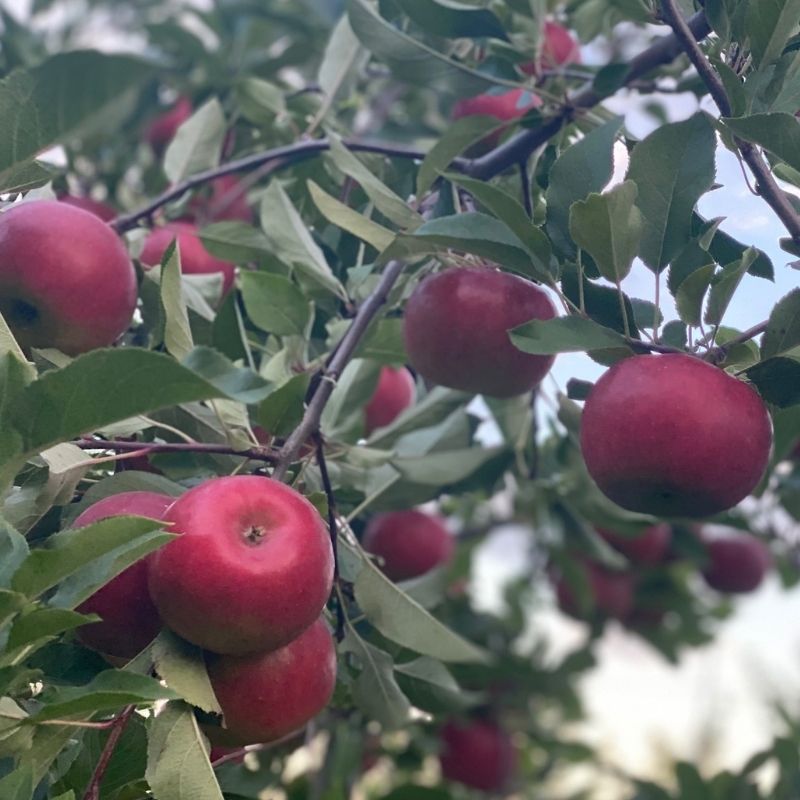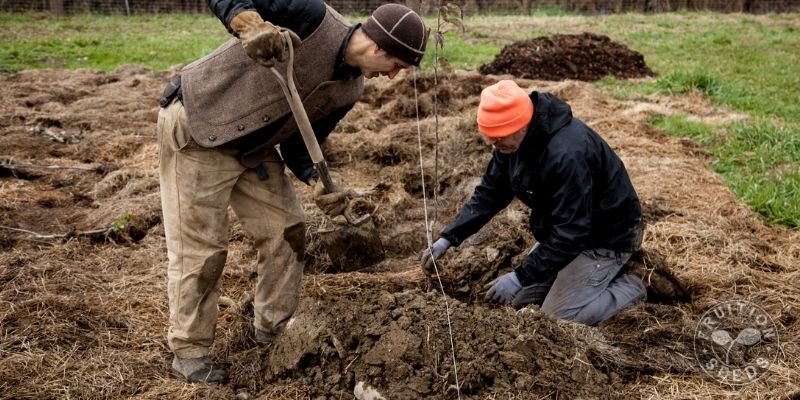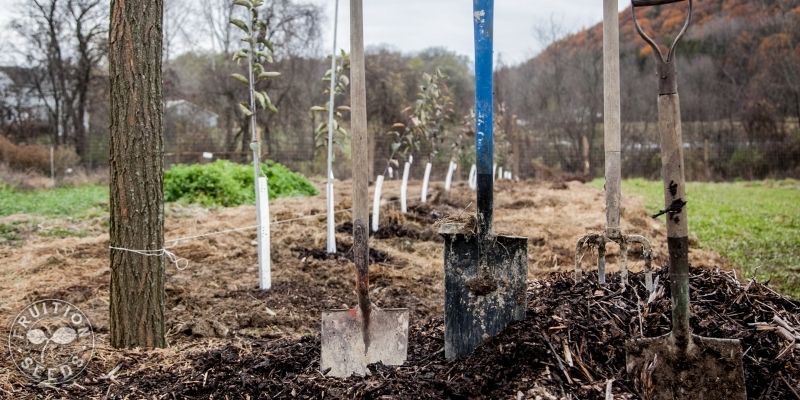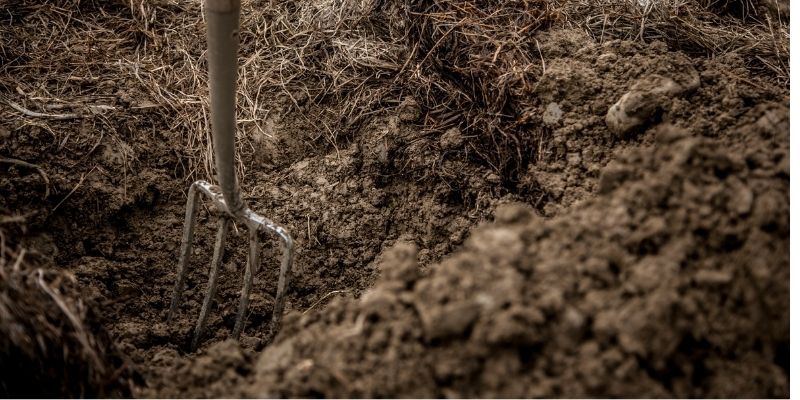How deep? How wide?
Are you digging into sod? Plowed soil?
There are so many considerations!
Here are the keys to keep in mind:
Depth: Your tree’s roots are your guide! Our goal is for the very bottom of the trunk to be level with the surrounding soil. The bottom of the trunk is where the color changes to the root zone; usually this is evident by a distinct line between trunk and roots. Depending on the size of your bare root stock, your hole may be 10 to 24 inches deep or deeper.
Why? Unlike roots, tree trunks do thrive with consistent moisture. If a tree is planted too deep, the moisture from the soil or mulch touching the trunk will eventually lead to rot and fungal issues, as well as suckering from the root systems. Alternatively, trees planted too high will eventually have exposed roots which will perish from exposure to air.
As a general rule, it is better to err on the side of caution and plant a little high than too deep. This is because as the soil settles, the tree may sink a little. As organic matter builds up around the tree from mulching, it will eventually rot the base of the trunk if it is below soil level.
Width: Three feet is a solid minimum which (you’re right!) is so much wider than the hole is deep. This is, in fact, the goal. Apple trees thrive when planted into holes that are wider than they are deep, encouraging their wide feeder roots to expansively explore.
Why? Tree roots can spread horizontally as well as down, with most of the ‘feeder’ roots growing in the top six inches of soil.
As a general rule, err on the side of a wider hole. Loosening up soil around the edges will enable the roots to grow more wide and more easily! The wider the hole and subsequent mulch ring, the longer it takes for the surrounding grass to creep into the mulch around the trunk. When we need to remove sod, we aim to do at least a 3’ diameter mulch ring.
If we really want to be precise in our circle making (which is entirely unnecessary), we use our measuring tape and spray chalk to draw a perfect circle as we do a loop around the stake. Many times, we’ll just measure the desired radius and guess the rest of the way.
Are you digging into sod? Stay tuned for our blog sharing the pros and cons of diverse approaches of preparing soil well ahead of time — or not at all!
In the meantime, a note on digging into sod: Removing grass is a lot easier when it’s mowed very short. Mow the area surrounding the tree to decrease rodent habitat. Keep in mind one of our goals is to always keep grass from touching the trunk. When grass is up against the trunks of the trees, even for a short amount of time, they usually become infested by round-headed apple borer and other disappointments ensue.
Digging the Hole: Use a round-pointed shovel or nursery spade, as your soil and body prefer!
Pile the soil in a single, small mountain adjacent to your hole. If you’re digging into and around sod, you may wish to park your soil on a tarp or piece of cardboard to help return it to your hole with ease.
Loose, crumbling edges are essential. If your soil is saturated and more loam than sand, you might notice smooth, sheer sides forming as you dig your hole. Such edges will inhibit root expansion, so loosen them with a digging fork to create a stucco-like ‘leavened’ side that will be open for roots, mycelium and life of all kinds.
Molehills & Mountains are all relative! Create a small mound of loosened soil at the bottom of the hole that the roots can be spread over, helping eliminate potential for air pockets under the roots.
Rocks: Our mentors have shared diverse views, from removing all rocks larger than 1.5 inches to removing none. Our general sense is that if your soil is largely gravel and stones, making room for nutrient-dense soil may be best for your tree, though it’s crucial for the original soil to be returned fully to the hole. If your back-filled soil to significantly more rich than the soil around your hole, your tree may resist growing beyond the hole, becoming partially root-bound.
Fruition’s current online tree growing resources are focused on Apple Trees (and it is also true that Pears, Plums, Peaches, Apricots and Cherries require much the same site choice, planting, and basic care considerations!) On that note, we hope you'll enjoy Fruition's free full library of Growing Trees Resources. Also recommended are all books by the late Michael Phillips and the online resources at the New England Tree Fruit Management Guide. In the meantime, enjoy more Fruition tree growing resources:
Apple Tree Growing Guide
Fruit Q&Qs pre-recorded Webinar Library
and join us for future live Fruit Q&Q webinars here!

Be in the know:
Fruition's Fruit Tree Updates!
You'll receive seasonal tree insights & how-to's plus be the first to know about invitations to tree events on-farm and online!
Visit our newsletter website and subscribe to the 'Tree Updates' section
Enjoy our free online Apples & Organic Orcharding course and Tree Webinar Q&Qs Library in the meantime & don't be shy!
~When you join us, check your inbox for your welcome & access info! Stay tuned for our weekly organic gardening tips & inspiration, as well~




